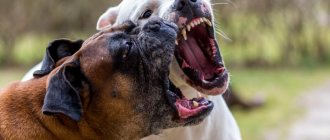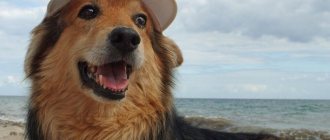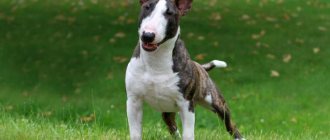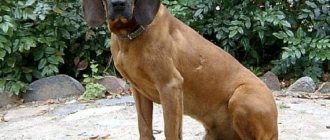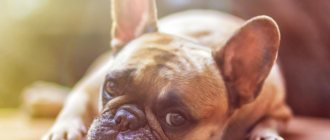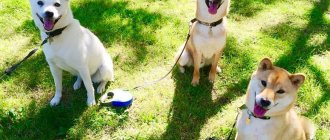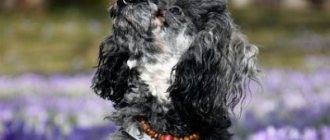4.7 / 5 ( 3 voices)
The stereotype that a pet should be fluffy and soft has long been debunked. Hairless animals are popular not only because of their hypoallergenicity, but also because of their non-standard appearance. They are in no way inferior to dogs with long coats, they adapt better to hot climates, and most importantly, they do not shed.
There are only 3 recognized hairless breeds: Chinese Crested, Mexican Hairless and Peruvian Orchid. The rest are either completely uncommon in the world or appeared due to a genetic mutation.
Chinese Hairless Crested Dog
The most popular hairless dog, brought to Europe at the end of the 19th century from China. The animals cannot be called completely bald: they are characterized by the presence of a white crest, feathering on the ears and a tassel on the tail. As for the rest of the body, they are covered with thin elastic pinkish skin with bright brown pigment spots.
These dogs are not working dogs. Since ancient times, since the times of the Chinese Empire, they have been valued as sacred. And in European society, the breed became a symbol of eccentricity, so its first breeders were stars with an unusual image or lifestyle.
The dogs have a graceful figure: long thin limbs, a curved back with a smooth neck, and a lean belly. They are dexterous, fast, and capable of learning. In the Crested family, they are kind, flexible, and loving. They get along well with children and other pets, but require attention. Without care, such pets become sad and find it difficult for them to be without their owner for a long time.
In Russia, a puppy can be purchased for 10-20 thousand rubles. The price will depend not only on class and pedigree, but also on appearance. Downy Chinese Cresteds, completely covered with wool, will cost a little more.
Features of ear care
To ensure proper ear care for your pet, you should follow several general principles.
Maintenance must be regular
After each walk, you should inspect the dog’s ears in order to notice and remove ticks in time (ears, paws and tail are favorite places of attachment). Once a week, the ears need to be examined in more detail, looked into the ear canal, and, if necessary, cleaned and treated. To clean and disinfect your ears, you can use Bars lotion, which has disinfecting properties and facilitates the removal of dirt, earwax and secretions resulting from infectious or inflammatory diseases of the ears.
Care must be gentle
Dogs' ears are very sensitive and vulnerable. Therefore, for cleaning you should use only safe tools and products approved for use in veterinary practice. To clean the inside of the ear, place 2-5 drops of warm lotion inside. Then, soak a swab or cotton pad in the lotion, gently wipe the inside of the ear. After this, change the disc and soak it in the lotion again, gently wipe the curls at the base of the ear, without going deeper. These steps should be repeated until the surface of the cotton pad remains clean. You should not clean the inside of your ear with chopsticks; it is too easy to cause damage.
Care must be rational
If your dog has a lot of hair on the inside of the ears (especially long hair), it should be trimmed regularly with round-edged scissors or plucked according to breed standards. Long hair protects the pet's ear canal to a certain extent. But it also prevents the removal of dirt and wax from the ears and serves as a reservoir of impurities that can harm the dog’s health.
Mexican hairless dog
Xoloitscuintles are native dogs that originated in southern North America . They were bred by the Aztec tribes, who considered animals as messengers of the afterlife. Pets were buried along with the owner, burned, and eaten. Despite such cruelty from humans, the Xolos remained good-natured and loyal.
Mexican hairless puppies are born with thick-footed, stocky puppies. By the age of one year, they take on the appearance of an adult dog: a fit body surrounded by thin folds of skin, a serious, confident look, strong limbs. It is normal for the breed to have hair on the head.
Xolos can be called calm, reserved, balanced. They feel great alone, but are fine with noisy families, children, and other animals. They need a leader-owner who can show the qualities of a real leader and choose the right approach in communication and education.
The Indians considered dogs to be healers. Due to their high body temperature, Xolos acted as a heating pad if their owner caught a cold.
Animals have sun-sensitive skin that is prone to dermatitis, which is important to consider when purchasing. In all other respects, the pets are unpretentious. It is difficult to find a real Mexican Hairless puppy in Russia; the average price for the breed is 50-60 thousand rubles . Purebred puppy is determined by three criteria:
- Dull face;
- Thick paws;
- Abundance of skin folds.
American Hairless Terrier
Descendants of the Rat Terrier, the American Pied Piper, which arose due to a gene mutation. The hairless puppies that were born caused a wave of disapproval and could have gone unnoticed, but interested enthusiasts decided to create a new breed for people suffering from allergies.
The dogs cannot be called completely hairless: they have a small beard and sideburns. Puppies are born with down, but it completely falls out by 2 months. Animals acquire different colors with all sorts of pigmentation options. Their body is strong and robust, the head is dry and wrinkled with small eyes. But the main advantage of the breed is its large triangular ears.
Such pets are very sensitive and understanding. They love to “talk” with the owner and listen to him. The animals are non-aggressive and treat children and strangers normally. But you should not bring your Terrier into a house where there are guinea pigs or other rodents.
The lack of wool did not affect working qualities. American Hairless remain good rat catchers and are easy to train and train. In addition, they need regular intense physical and mental exercise. The only problem is the need for heat. It is better not to get a hairless dog in cold climates.
The breed is not common in post-Soviet countries, so it is difficult to find purebred puppies. Such a baby will cost no less than 50 thousand rubles.
Basset Hound
The appearance of a pet of this breed can be described as a dog with long ears and sad eyes. This breed was developed in France in the 19th century to hunt small game. The Basset Hound is a small dog with a long body, short legs, and large dark eyes. Their muzzle is of medium length and their nose is wide. The colors are tri-color (brown, orange and white) and bi-color (orange and white), the paws are usually always white.
Purpose
Today, Basset Hounds are used both for hunting and as companion dogs.
Character
Dogs of this breed are not aggressive towards people; they have a calm, phlegmatic character. Such pets can be stubborn and wayward. They get along well with small children and other dogs.
Care and maintenance
Basset Hounds enjoy long walks with a moderate level of activity. You should monitor the ears, eyes, folds on the face, wipe as necessary, trim nails. The coat needs to be brushed periodically. You can keep it both in a country house and in an apartment, but subject to constant walks.
Peruvian Inca Orchid
Rare breed in Europe, but common in Peru . The animals are believed to be non-native, having been brought from Africa or China. Images of similar dogs were found on the rock slabs of the ancient Incas. Peruvians treat dogs as deities. They are kept not only as a pet, but also to protect the house from evil spirits.
The dog got its name because of the funny crest on its head and the ability to change skin color depending on the seasons: in winter - light, beige, white; in summer – pinkish.
These are muscular, medium-sized animals with elastic skin. There are 3 growth varieties:
- mini (8 kg);
- standard (12 kg);
- maxi (25 kg).
Representatives of the breed are accustomed to hot climates and a nocturnal lifestyle, so owners should not worry about the pet sitting at home alone while everyone else is working. Orchids will most likely sleep all day.
The dogs are very loving and gentle, calm and affectionate. They are not characterized by playfulness, aggressive behavior, or isolation. The dogs have a lively mind, which allows them to be taught not only the basic program, but also to pick up additional commands or tricks.
Peruvian orchids quickly become attached to the family, respect not only one owner, but also all members of the household, and treat rodents and birds normally. But they don’t like strangers because of their pronounced territorial instinct.
Like other southern dogs, Peruvian Orchids are a rarity for the Russian Canine Society. There are several nurseries in the country that specialize in breeding the breed, so the cost of a puppy is 56-60 thousand rubles.
Ear cropping for Central Asian Shepherd
The procedure for trimming the ears of Alabays (Central Asian Shepherd Dogs) is traditionally carried out in the country of origin of the breed (Russia and CIS countries) and in those countries where this manipulation is not prohibited by law. International breed standards describe undocked dogs. The Russian version allows both types of ears. The decision to carry out the operation is made by the breeder or owner of the Alabai. Let's look at the main arguments for and against the operation.
Arguments of those who advocate docking of Central Asian Shepherds:
- the operation emphasizes the breed, dogs with floppy ears look like mestizos;
- This surgical procedure protects service dogs from certain injuries.
Arguments of opponents of docking:
- surgery is a risk to the dog’s health;
- cupping is purely aesthetic and has no practical benefit;
- This is a painful and uncomfortable procedure for the pet;
- Alabai with cropped ears are more aggressive.
Manchurian Hairless Dog
The breed is unrecognized and is considered an offshoot of the Chinese Crested. Appeared in Manchuria, bred as an absolutely hypoallergenic dog that never becomes infected with ectoparasites. Another feature is the complete absence of odor.
Manchurian dogs are similar in appearance to Crested dogs: long limbs, thin pink skin, feathering on the ears and tail. By nature, animals are soft, kind, obedient and flexible, often shy and withdrawn in the absence of proper socialization.
In Russia it is almost impossible to buy such a pet, but on the world market the cost of a puppy varies from 25 to 40 thousand rubles.
Ecuadorian hairless dog
The place of origin of the breed is Guatemala, it is believed that it appeared by mixing the blood of Peruvian orchids and Mexican naked ones. These dogs are difficult to find even in their historical homeland. They are not sold, they are not specially bred, there is not a single kennel that would offer to purchase an Ecuadorian Hairless puppy.
Animals are bred in Ecuadorian and African villages, in uncivilized forest tribes. Dogs help people around the house, hunt rodents and entertain children. Priests are confident in the ability of pets to drive out evil spirits and heal body and soul.
It is believed that this breed is the smartest among hairless ones, although there is no confirmation of this opinion.
Overall, Ecuadorians make excellent companions. They are cheerful, friendly, active, but willful and freedom-loving, like all aboriginal dogs.
Hairless Deerhound (Scottish Greyhound)
An unrecognized breed that appeared due to a mutation in the standard Scottish Greyhounds. The recessive gene produces puppies in a litter of ordinary dogs that lose their hair by 3-4 weeks after birth. This phenomenon is not caused by a disease (alopecia), but such babies are discarded in order to prevent the mutation from developing.
Hairless Deerhounds are not suited for hunting due to their delicate skin and frail build, so they are functionally useless. And in their homeland, in Great Britain, greyhounds are valued precisely for their working qualities. But, despite such a non-standard appearance and poor health, Hairless Scots make excellent pets. They are loving, gentle, brave.
It is almost impossible to purchase a hairless individual; all puppies are left in the nursery for birth control. Although enthusiasts continue to fight for the independence of the breed and its recognition by the world canine organization.
Beagle
This dog with long ears belongs to the hunting breed. She was bred in Great Britain to hunt hare and rabbit. The weight of such a pet is 15-20 kg, height is up to 40 cm. The coat is most often tricolor: black, white and lemon.
Purpose
The Beagle is not only a good hound dog, it is also used by the police for search work, as they have a very good sense of smell and can detect illegal substances. Often such pets are adopted by active people as a companion dog.
Character
These are very friendly dogs and get along well with all family members and other animals. They are very smart, active, mobile, curious. Due to their stubborn nature, they may have difficulty learning and training.
Care and maintenance
Beagle can be kept in an apartment and in the private sector. But at the same time, the dog simply needs frequent walking and physical activity. Therefore, they are suitable for active people. It is also necessary to inspect and clean the eyes and ears, trim nails and periodically brush out dead fur. It is recommended to monitor diet, as this pet is prone to obesity.
Advantages and disadvantages
Beagle owners highlight the following advantages of this breed:
- friendliness;
- activity;
- lack of aggression;
- playfulness;
- devotion;
- cheerful character;
- endurance.
The disadvantages of this breed include the following:
- difficulty of training;
- trustfulness of strangers;
- lack of security qualities.
A dog of this breed must be socialized and trained so that negative qualities do not prevail over advantages.
African hairless dog
The second name is Abyssinian sand terrier . One of the rarest breeds (about 400 individuals worldwide), it is very difficult to find representatives in Russia. Therefore, practically nothing is known about dogs.
Like all hairless dogs, Terriers were considered sacred and were used in ritual ceremonies. Almost nothing is known about the history of animals. Approximate place of origin: Africa. There is an opinion that the animals became the basis for the breeding of Chinese crested cats . The breeds are similar in size, build, and color. Abyssinians also have hair on their head and tail.
An interesting fact is that dogs cannot bark, but they can learn to do so by hearing the “conversation” of their relatives.
Regardless of whether the voice has emerged or not, Abyssinian Terriers are very brave and courageous, ready to protect their owner, despite their modest size (up to 25 cm at the withers). Animals do an excellent job of protecting property, but raising and training them is difficult, so natural habits and instincts often take over.
African Hairless cats are gentle and attentive, love their family, and treat children of all ages well. Dogs understand their owners on a moral level, support and reassure.
Top 10 eared dog breeds
We present to your attention the 10 most common dog breeds with long ears, their photos and names.
- Cocker Spaniel
Probably every person knows what exactly the breed of dog looks like. Perhaps her appearance is one of the most memorable. This breed is very popular; its representatives have a cheerful disposition and cute appearance. Dogs of this breed are perhaps the best companions. The breed was developed back in the 19th century, but was officially recognized in 1974.
Dogs of this breed are very sociable and are always happy to interact with humans. They want to be in the spotlight more often. They also love to play and frolic, they are active and are always happy to go for an extra walk. They don’t have laziness, so they won’t just sit on the couch with you. They have hunting instincts in their genes, so they need physical activity. They treat strangers with distrust, but they are not good guards. They get along well with children and other pets and get along well.
- Dachshund
Another breed of dog that every person knows about - what it is called and what it looks like. Dachshunds are small dogs with short legs and long ears. By their purpose they are hunters. Using their body shape and short legs, they can climb into holes and hunt rabbits and badgers. Dachshunds originated in Germany. Dachshunds have different coats depending on their type - mini, standard or rabbit.
By nature, dachshunds are friendly and playful. In addition, they have high intelligence and endurance. This breed is suitable for families with children, with whom dachshunds quickly get along. They also get along with other pets.
- Basset Hound
Dogs of this breed have very long ears, which she even sometimes accidentally steps on. Outwardly, this dog looks sad because of its eyes. They can reach 30 centimeters in height. The breed originated in England. The coat color of these dogs can be two or three colors.
By nature, hounds are very cheerful and positive. They are not lazy, they can spend hours on walks and give others a good mood. They get along well with children and other pets.
- Beagle
This breed is also a hunting breed; they can chase hares. These dogs are quite small and restless, very curious. The breed originated in England. Beagles make good companions and are very sweet and kind. Dogs have a high degree of activity, they like to take long walks and spend their walks active. They are attached to their owners and treat children and other pets well.
REFERENCE! A special feature of beagles is their keen sense of smell, thanks to which they are recruited to serve in the police.
- Drathaar
The Drahthaar breed is called the best hunter of all cops. They are very good at picking up a trail and following it. In addition, they can run for a very long time without stopping, and are also good guards. This breed was developed in Germany by crossing several different breeds.
The drathaar's appearance is distinguished by long ears and coarse fur that resembles wire. Under the fur of these dogs there is a dense undercoat, thanks to which the pet does not freeze even in severe frosts.
Drathaars are very devoted to their owner, most often identifying him for themselves and following him. They love active games and get along well with animals in their home, accepting them as part of their pack and protecting them. By the way, some of them are very good guards. They can also become a caring nanny for your child.
- Shih Tzu
Shih Tzus resemble lap dogs in appearance. The breed originated in China back in the 17th century. They have an unusual mane and fur on their face. These dogs are very sweet and do not impose themselves on their owner. Suitable for families with children. A small dog with long ears does not need a lot of space in the house, nor does it need long walks. However, caring for them is complicated by taking care of your pet's fur. She needs to be looked after very carefully. Dogs of this breed are very gentle and grateful for everything to their owner, becoming excellent companions. But the guards do not leave them. Shih Tzus cannot stand being alone for long periods of time.
- Papillon and Phalene
The dogs of this breed are very small and have interesting ears that look like butterfly wings. If the ears stand up, then the breed is called Phalene, if they hang, then it is Papillon. This breed originated in France, but no one had heard of it for a long time. The breed standard was developed only in 1923, when the first exhibition took place.
Papillons have great affection for their owner and do not want to be left alone. They make excellent companions as they are very curious and active. Training and raising pets of this breed is quite simple. They get along well with other animals, but can conflict for some serious reason.
IMPORTANT! These dogs need fairly early socialization, then no problems should arise with their upbringing.
- German dog
They are very large dogs and when you look at them you remain impressed for a long time by their size. As the name implies, the breed originated in Germany, and a standard for them was developed in 1880. Dogs have large ears that can stand up or hang down.
REFERENCE! The largest dog in the world was the Great Dane breed. She weighed 111 kg and had a height of 110 cm.
Despite their enormous size, they are not at all aggressive, but if necessary they can show it. They treat other animals well and try to protect them. Although a large dog with long ears is not a service breed, it is capable of protecting the owner and his home from uninvited guests. They treat strangers with caution. Great Danes are very loyal and intelligent dogs.
- English Setter
These dogs were bred for hunting in England; they are sometimes called Laveracs after the breeder's name. English breed of dogs with long ears
Outwardly, it is distinguished by long, hanging ears, which are covered with wavy hair. These dogs are very smart, sociable and curious. They feel very good among a large number of people and animals. They also get along well with children.
Since setters are hunting breeds, it is necessary to take them for long walks every day, combining this with interesting games. In addition, pets love to swim and dive.
- Porselen
A truly hunting breed of dog, very independent and reckless. To raise and train a Porcelain, the owner must be experienced and have a strong character. Representatives of the breed have an excellent sense of smell and endurance. Externally, they are very elegant and have white shiny fur. The breed appeared in France.
A white dog with long ears is loyal to its owner, but it requires strong physical activity. They really like hunting, and in its absence, active games. Children will not be offended.

